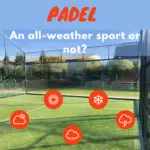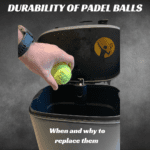This post may contain affiliate links.
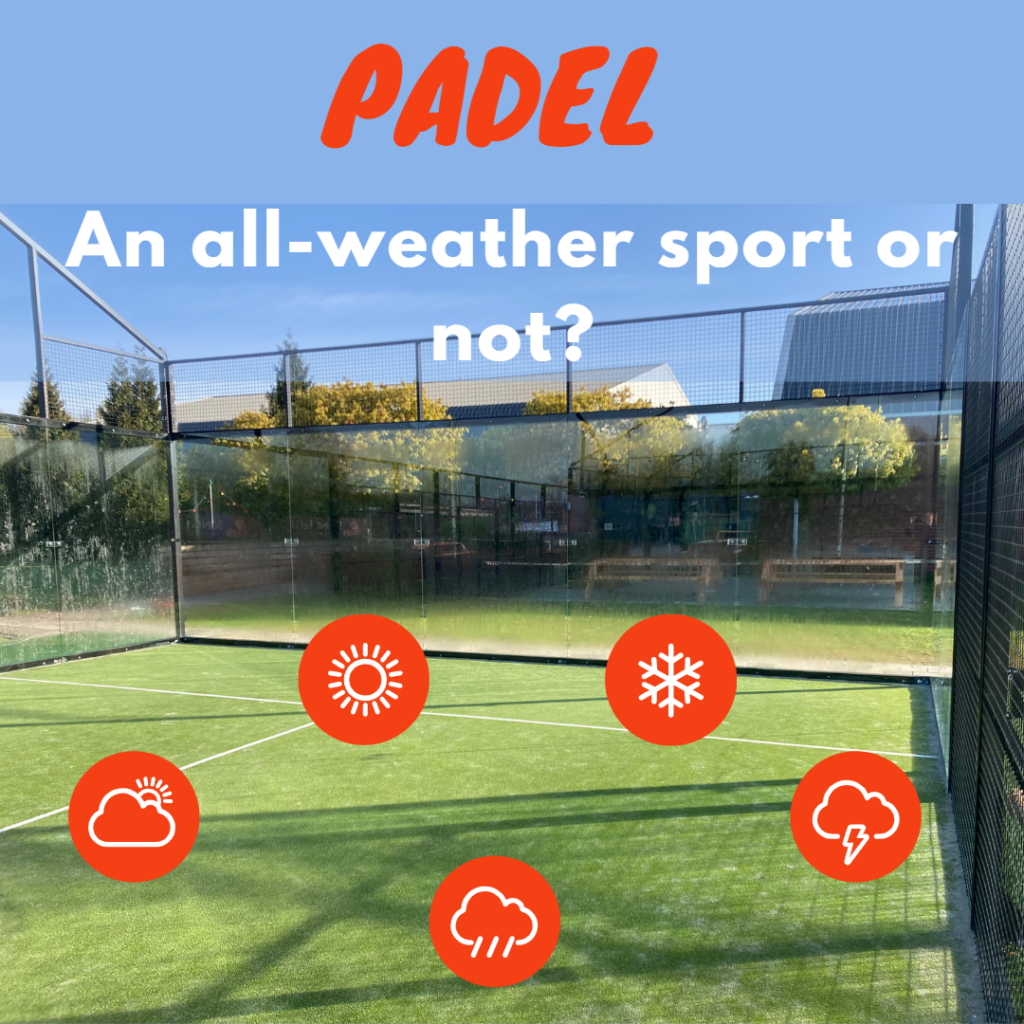
Padel is booming in many countries around the world, but can it actually be played in all types of weather? That is why I decided to find out the impact of the weather conditions on the court and the playing experience.
Padel is not considered an all-weather sport, since certain weather conditions hinder the playing experience severely. Nevertheless, padel is a growing sport that is played in many different countries with different climates.
While all-weather covers many aspects and topics, I will break it down for you in a structured manner. Let’s look at the different questions and feel free to jump around if you are only interested in a particular topic:
- Can Padel Be Played Outside?
- Can You Play Padel In The Rain?
- How Does Rain Affect Padel Courts?
- How To Play In The Rain : My 5 Effective Secrets
- Can You Play Padel In Winter?
Can Padel Be Played Outside?

Padel can be played on both indoor and outdoor courts, although it started out as an outdoor sport. Colder, windy, and more rainy climates benefit from indoor courts, whereas outdoor courts are more suitable for warmer and steady climates.
While I enjoy playing padel outside, there are some factors that impact the playing experience:
- Sun : The glaring sun might blind you when you are trying to hit an overhead or try to follow your opponent’s lob. If the sun is lower, the glass wall reflects the sunlight.
- Wind : Playing overhead in padel is all about timing, so what is worse than you preparing your shot correctly, only to have the wind change the course of the ball? Well, more times than not you will miss the ball completely or hit the ball outside of the sweet spot (of your racket).
- Heat : Direct exposure to the sun is nice only if it is not too hot. Playing too long in the hot sun can even cause a heat stroke.
You might wonder, why is rain, snow, and ice not mentioned. As you might have noticed from the overview, we’ll cover those later in much greater detail.
Playing indoors might be the best solution if it is really hot, on the other hand, it takes a lot of cooling to make it enjoyable. I do not recommend playing at an indoor facility with a low roof when it is above 30° Celcius or 86° Fahrenheit. Having played a couple of times during these conditions, I can tell you this … it’s practically a sauna.
Depending on the temperature (and your comfort level), playing indoors at a bigger facility (with a higher ceiling) can be definitely enjoyable. A larger facility results in more airflow and there is more distance between the roof and the floor (where you are playing).
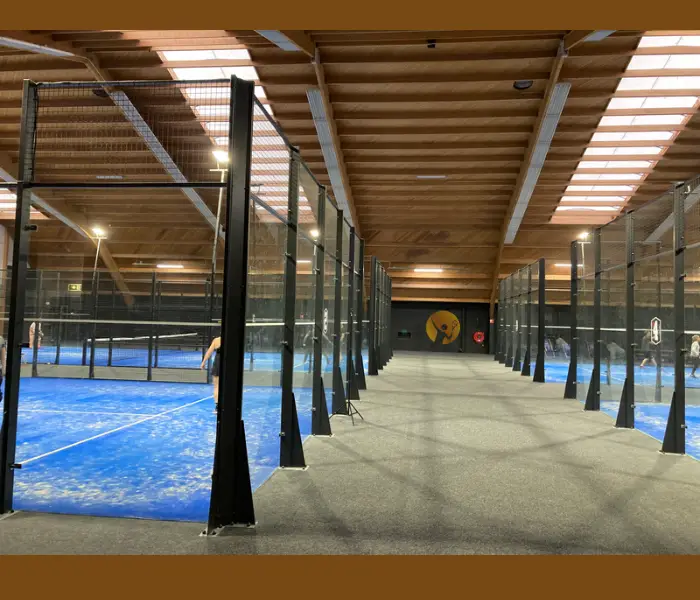
Covered Outdoor Padel Courts
Another option that some facilities offer is covered outdoor courts. For the ones that are not familiar with covered outdoor courts, it is basically an outdoor court with a big roof. Although measurements can vary, the minimum measurement would be 10 by 20 meters (in order to fully cover the court itself).
However, it makes more sense to make it a bit bigger (14 by 24 meters for example) in order to ensure it cannot rain on the court. Why make it larger you might ask?
First of all, the higher the roof is placed, the greater the chance that rain can come in from the sides. While in theory, you could place the roof directly on top of the back fences (at a height of 4 meters). As a result, it would be less likely that rain would enter the court. However, based on regulations, the minimum height for padel courts is 6 meters.
It goes without saying that the higher the ceiling, the better it is in terms of playing proper (high) lobs. While you might conclude you want to place the roof as high as possible, not so fast!
I hate to break it to you, but increasing the height makes the cover more exposed to the wind. Therefore, these covers are usually placed at a height of 7 meters. Personally, I feel that 7 meters are still a bit low, limiting the possibility of playing all sorts of lobs.
As mentioned, many sizes of covered courts exist. In general, smaller roofs are great for outdoor courts, while large roofs covering more than 4 courts feel more like a hybrid version of an indoor and outdoor court. But hey, maybe that is just me.
Can You Play Padel In The Rain?
In general, padel can be played in the rain as long as the rain is not too heavy. Too much rain negatively impacts the playing experience. Also, in the longer term playing in the rain will negatively impact the durability of your padel racket.
Again, some light drizzle does not harm your padel racket. To support this statement, allow me to be a bit self-centered and quote myself:
In general, rackets can get wet as they are made to be played on both outdoor and indoor courts.
Thom Hordijk – 10 Secrets To Improve The Lifespan Of Your Padel Racket
However, if you are concerned about the lifespan of your racket you definitely want to check out 10 Secrets To Improve The Lifespan Of Your Padel Racket. You might learn a thing or two …. about rice as well!
While we now know that in principle you can play in the rain, let’s take a closer look at the impact of rain on a padel court.
How Does Rain Affect Padel Courts?
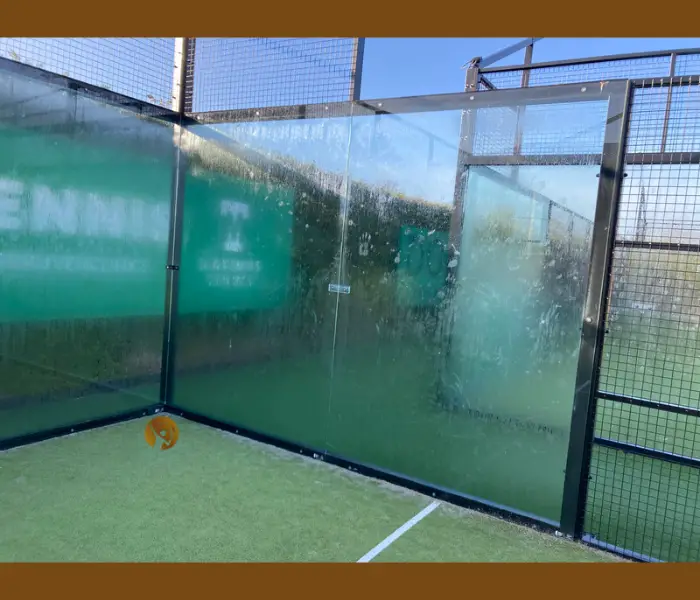
A padel court construction is made to withstand rain and is not directly affected by rain. Although rain can make the turf slippery, excess water can escape through the drainage system which is part of the foundational construction.
If you want to learn more about considerations to take into account during the construction of padel courts, check out this article.
While the padel court itself is not directly affected by rain, it does not mean that rain does not affect the game of padel. And as you might have guessed by now, the biggest impact that rain has is on the playing experience itself.
As mentioned, the turf can become slippery, but in my experience, this is not an issue in practice. The biggest problem is the fact that the glass walls become unusable, especially when both the glass walls as well as the ball are wet. The ball becomes much heavier and less bouncy as a result. On top of that, the ball loses all of its friction and will slide against the wall rather than bounce.
In padel the glass walls are used often and the game largely depends on the predictability of the trajectory of the ball. To illustrate my point, let me walk you through the following scenario.
Imagine you are anticipating to return the ball after the side glass. You are preparing early by positioning correctly and taking your racket back early.
So far so good I would say..
The ball bounces before the service line, bounces up goes toward the side glass. But just when it touches the glass, the ball flicks off the side wall.

It is just like the ball takes a dive on the Slip and Slide (aka water slide). Rather than that the ball bounces off the wall in the same trajectory, as soon as the ball touches the glass it changes its course and stays close to the wall.
Well, it must not come as a surprise that are not ready to return that ball, after all :
In padel the glass walls are used often and the game largely depends on the predictability of the trajectory of the ball.
Since I want you to keep afloat when you find yourself playing in the rain .. I will give you my 5 effective secrets.
How To Play In The Rain : My 5 Effective Secrets
- Avoid playing your shots with spin, since they are less effective in the rain. This holds for both topspin and slice/backspin. Playing the ball with spin
- Avoid playing balls against your own wall (also known as ‘contra de pared’), since the ball is likely to slide against the back wall and not even make it to the side of your opponents. Moreover, I recommend using this shot (in normal conditions) as a last resort anyways, since it is generally an easier return for your opponent.
- Play the ball against your opponents’ walls (either side or back wall) since the response of the bounce is less predictable due to the rain.
- Don’t try to smash the ball out of the court, since colder temperatures and rain are not a great combination to smash it out of the court anyways. Therefore it is less likely to happen and you might even give your opponent an easy return. Just don’t, it is not worth the risk of losing the point. After all, it is a low-percentage shot in that situation.
- Use the KISSS method : ‘Keep It Simple, Serve and Smasher’ ! Trying to play a high-risk shot is not likely to pay off in the rain, since the ball is already behaving irregularly. Trying to overdo it might have the opposite effect. On top of that, you are also more likely to receive an irregular ball, thus increasing the chance you hit it off target or even make a mistake.
Can You Play Padel In Winter?
Padel can be played during winter times unless the court is covered by snow or ice. After all, padel courts are made to withstand cold temperatures as long as the concrete foundation is deep enough to prevent frost action.
For the players, you would not care about the foundation part, since the padel court is already built of course. Would it be overkill to explain why it is not possible or even dangerous to play when the court is covered in snow or ice?
I guess so, but on the other hand, I don’t want you to hurt yourself. A decent layer of snow will prevent the ball from bouncing, let alone prevent you from running around. While snow prevents you from playing at all, ice will just make it dangerous to run around. On top of that, it will result in unpredictable bounces.
However, in practice, ice should not be an issue, since excess rainwater should drain through the turf and concrete. If there is no water, there will be no ice.
But for the curious minds that wonder how deep the concrete foundation should be, I’ve got you covered. The recommended minimum depth of the concrete beam is 45 cm or about 18 inches (and even 1 meter for clay-type surfaces). Interested in more foundational padel court construction stuff with concrete examples, then smash the link.
Although we only covered the impact of winter conditions on the court, you might also want to know how these conditions affect your padel racket. Therefore if you haven’t seen it already, now might be a good time to read up on this article, covering the durability padel rackets and the impact that environmental exposure has on its lifespan.


